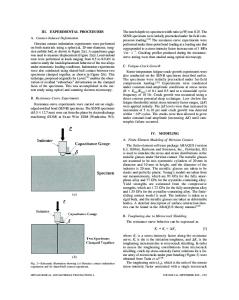Comparison of Fatigue Strengths of Bulk Metallic Glasses Produced by Tilt Casting and High-Pressure Casting
- PDF / 594,896 Bytes
- 7 Pages / 593.972 x 792 pts Page_size
- 42 Downloads / 347 Views
.
INTRODUCTION
ONE of the unique features of metallic glasses is their high toughness,[1–3] as compared with oxide glasses. pffiffiffiffiFor instance, the high toughness, exceeding 100 MPaÆ m; of Zr-based BMG[4] is almost equivalent to that of tool steels. Probably, the major reason behind the high toughness of metallic glasses is the presence of metallic bonds, which are characterized by a strong bonding force and a flexible bond distance. Therefore, these glasses can be readily subjected to engineering plastic forming within strictly limited plastic strains at room temperature, i.e., bending,[5,6] cold rolling,[7,8] and so on. Furthermore, these glasses generally exhibit the phenomenon of metallic fatigue with distinct knees on S-N curves (S: stress amplitude and N: number of cycles to failure), indicating the existence of individual fatigue endurance limits. Striation-like marks can be seen on fatigue-fractured surfaces, and they form during fatiguecrack propagation along shear-band networks in front of the fatigue-crack tip.[9–12] Since the initiation of a fatigue crack often occurs in an early stage[12] involving less than 104 cycles, fatigue-crack propagation is the significant factor in determining fatigue lifetimes. Nanocrystallization[13] and ductile crystalline particles[14] are effective in restricting the formation of a dominant shear band in front of a fatigue-crack tip that may lead to a YOSHIHIKO YOKOYAMA, Associate Professor, and AKIHISA INOUE, Professor, are with the Institute for Materials Research, Tohoku University, Katahira, Sendai 980-8577, Japan. Contact e-mail: [email protected] D. GARY HARLOW, Professor, is with the Mechanical Engineering and Mechanics Department, Lehigh University, Bethlehem, PA 18015. PETER K. LIAW, Professor, is with the Materials Science and Engineering Department, The University of Tennessee, Knoxville, TN 37996. This article is based on a presentation given in the symposium ‘‘Bulk Metallic Glasses VI,’’ which occurred during the TMS Annual Meeting, February 15–19, 2009, in San Francisco, CA, under the auspices of TMS, the TMS Structural Materials Division, TMS/ASM: Mechanical Behavior of Materials Committee. Article published online April 22, 2010 1780—VOLUME 41A, JULY 2010
catastrophic fracture. On the other hand, Ti- and Co-based BMGs exhibit extremely high fatigue limits exceeding 2 GPa,[15] whereas their fracture toughness is lower than that of Zr-based BMGs. Further, the sample size of Ti- and Co-based BMGs is limited to / 2 9 20 mm due to their low glass-forming ability. Small samples offer an advantage that the number of cast defects can be reduced using the conventional metallic mold casting method. Before subjecting BMGs to fatigue experiments, the reliability of their mechanical properties with sufficient reproducibility should be achieved. The major reason for a decrease in the reliability of mechanical properties is considered to be related to the presence of cast defects,[16] exemplified as crystalline inclusions, voids, cold shuts (SPEC: a discontinuity that appears
Data Loading...











